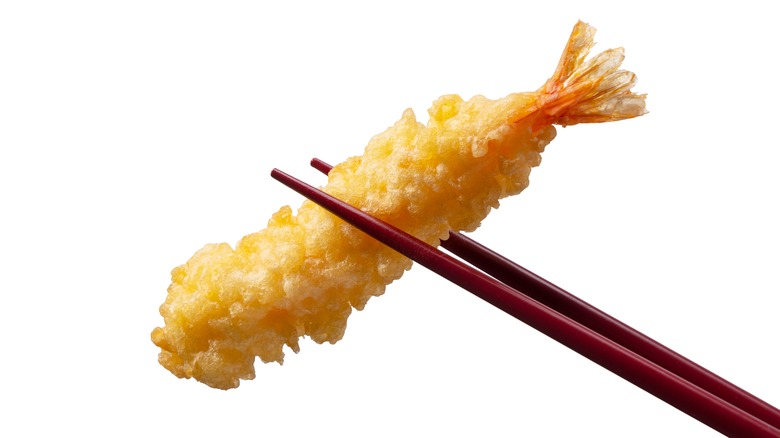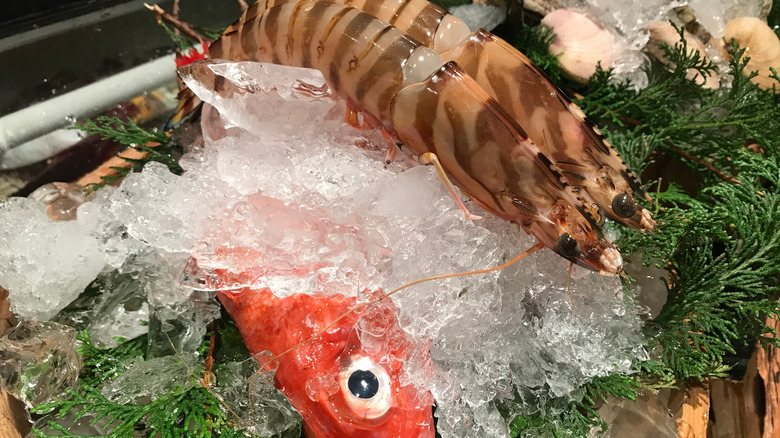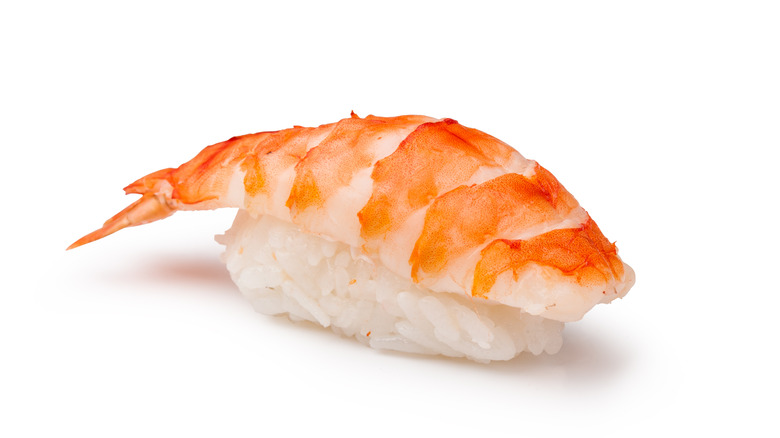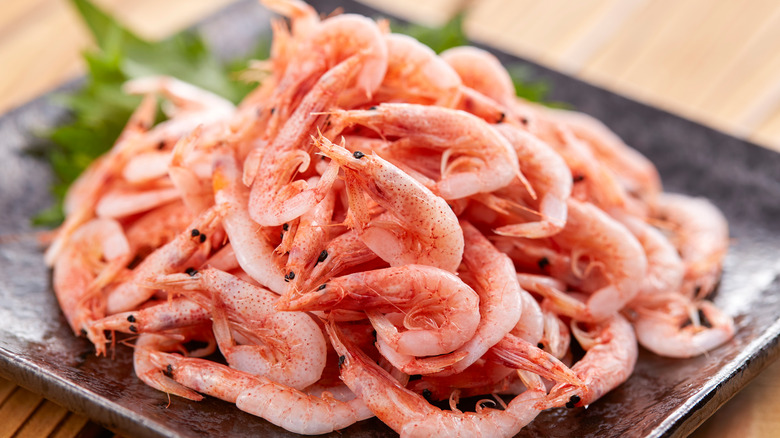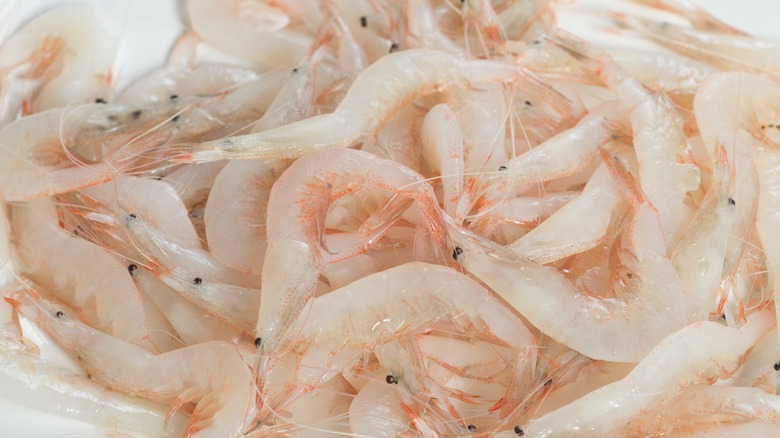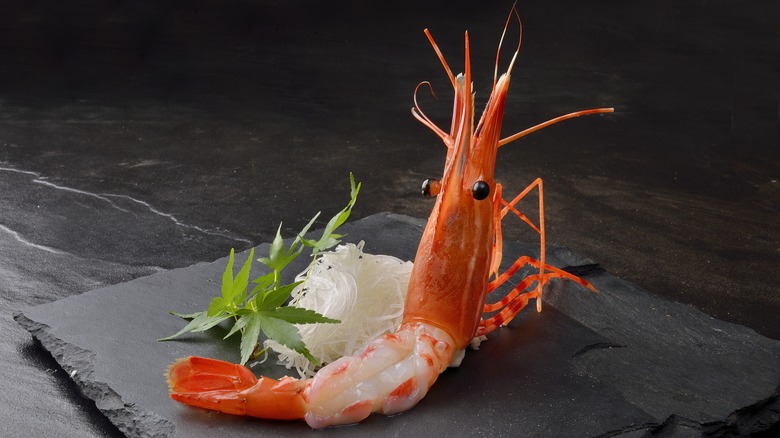What Are The Different Types Of Shrimp Used In Japanese Cuisine?
Ebi (shrimp) is a very common ingredient in Japanese cuisine. Whether you've enjoyed it fried as tempura, boiled and served as a piece of nigiri, or cut up into small pieces and rolled into a maki roll, chances are you've experienced shrimp multiple times in Japanese establishments across the United States. But did you know countless species of ebi are used for culinary purposes?
Although you might not recognize it — most shrimp look alike when peeled after all — Japanese chefs utilize multiple types of the seafood based on their size, taste, and seasonality. From giant tiger prawns eaten head- and tail-on to tiny shrimp best enjoyed raw and by the handful, you can find ebi in every kind of Japanese dish, from nabe hot pots to crunchy fritters. Differentiated by both flavor and texture, Japanese chefs have a type of shrimp for every application. Here are some of the common types you can find in Japanese restaurants.
Kuruma-ebi
One of the most prized kinds of shrimp for traditional Edomae-style sushi is kuruma-ebi, a high-end ingredient in Japanese restaurants. It comes in a variety of sizes and is especially prized for its aroma, sweetness, and intense visual appeal. Scientifically known as Marsupenaeus japonicus and commonly known as Japanese tiger prawns, they typically grow to sizes between four to eight inches. Although wild caught kuruma-ebi are rare, the prawns have been farmed in Japan, where they fetch a very high price of $40 to $130 per kilogram.
The best way to enjoy kuruma-ebi is to serve it as sushi after being briefly boiled in water. A skewer is used to prevent the shrimp from curling while cooked, and the partially-cooked piece is salted and dipped in vinegar before being served atop a bed of sushi rice. The head, which contains delicious fat, is sometimes grilled with salt and served to the lucky diner as a snack, often with a glass of sake. Sushi chefs at upscale establishments will also put the shrimp's miso (liver) in between the rice to add a rich, flavorful component to the piece.
Ama-ebi
Literally translated as "sweet-shrimp," ama-ebi — sometimes spelled without the hyphen — is a common sight at sushi bars in Japan and beyond where they are commonly served raw and butterflied as sashimi (as well as sushi). Also served raw, these shrimp are prized for their sweetness. In Japan, they are considered to be in season during fall and winter; during their spawning season in the beginning of the year, you can even savor the eggs that are attached to the bottom of their bodies.
There are actually two species of shrimp that are labeled as ama-ebi. The scientific name of the species from the northern Pacific Ocean is Pandalus eous, which are highly prized, especially during the period when the shrimp transitions from male to female. The ones that come from the northern Atlantic are called Pandalus borealis, and they are imported to Japan frozen. Considerably cheaper than their Pacific counterpart, this type of ama-ebi are mostly used for conveyor sushi restaurants.
Sakura-ebi
Known for their vibrant pink color, sakura-ebi, also known as cherry blossom shrimp and scientifically as Lucensosergia lucens, are very small shrimps that are only harvested during select months in Japan. Celebrated for their color, they are harvested at night and shipped out the next morning, where they can be turned into several kinds of dishes.
Outside of Japan, you are most likely to encounter sakura-ebi in the form of dried shrimp. They can be used as garnish atop rice, as a seasoning, used to make Japanese dashi broth to add a pop of umami, snacked as is, or incorporated into any dishes that require a crunchy texture, such as a fried rice or a salad of crunchy greens. In Japan, sakura shrimp can be eaten both raw and cooked as a sushi topping, but another common way to enjoy these tiny pink beauties is to fry clusters of them in tempura batter to make a fritter.
Shiro-ebi
Also known as broad velvet shrimp or Japanese glass shrimp, shiro-ebi are only harvested in Toyama Bay, on the western coast of Japan. Scientifically known as Pasiphaea japonica, these shrimps are relatively small, growing up to three inches in length. They are translucent in color when alive, but quickly turn white when cooked. Thanks to the fact that this type of shrimp spoils easily, it was not widely distributed until refrigeration technologies improved.
Due to its varying size, shiro-ebi can be used in different ways. Small specimens can be used to fill a battleship style sushi (also known as Gunkan maki), which is when a seaweed strip is wrapped around a base of rice to create a container for sushi topping. Large versions of shiro-ebi can be formed into traditional nigiri sushi. They are also marinated between sheets of seaweed, where the shrimp can absorb the natural glutamate salts to enhance their flavor.
Botan-ebi
Botan-ebi, commonly known as spot prawn and scientifically known as Pandalus nipponensis, is another type of shrimp you can find served raw on top of sushi rice in Japan. They typically measure between four to eight inches in length, and they are fished from cold waters north of Japan. Said to be even sweeter and more delicious than sweet shrimp, botan-ebi are said to pair well with the vinegar-prepared rice of traditional style sushi. The shrimp's blue-black roe, when available, are laid atop the sushi as a garnish.
Aside from these five types of shrimp, chefs at Japanese restaurants also enjoy imported shrimp from all over the word. For example, Argentian red shrimp is a popular alternative to botan-ebi, while multiple species of shrimp are farmed around the world and imported as an inexpensive alternative to kurama-ebi. These include the whiteleg shrimp, the yellowleg shrimp, and black tiger prawns. These less expensive alternatives are often served in inexpensive sushi restaurants to lower the cost of production.

